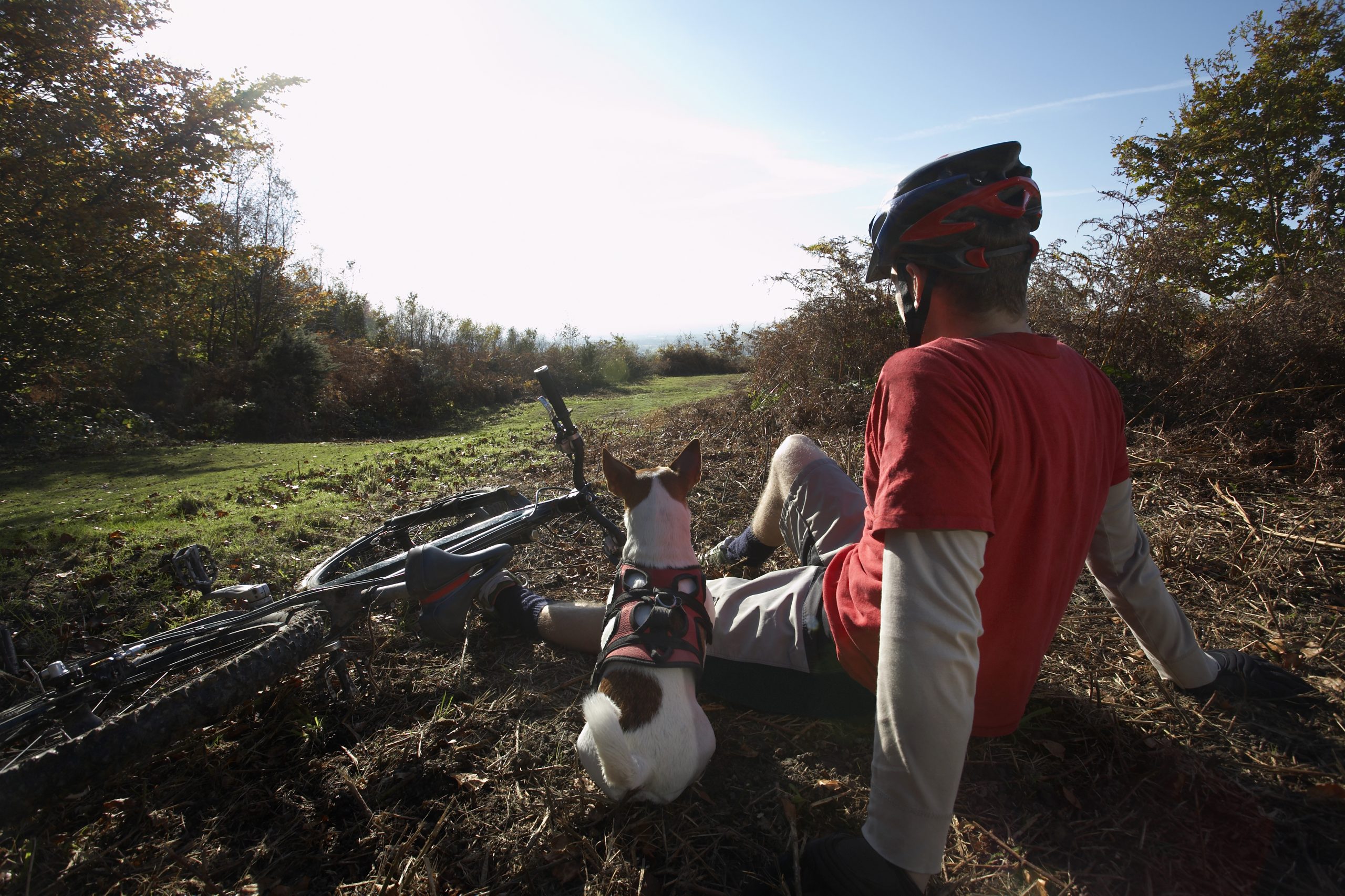Unleashing Your Cycling Potential: Strength Training for Cyclists
January 8, 2024
5640 Views
1 comment
SaveSavedRemoved 2

Table of Contents
Want to unleash your cycling potential and find out the best strength training for cyclists? Just read on. We will help you explore how to incorporate strength training into your routine that can revolutionize your performance, fitness, and injury prevention.
Strength training is crucial for cyclists because it targets key muscles used in cycling, such as the quadriceps, hips, hamstrings, and core. By adding strength exercises to your regimen, you will build endurance, and power, and enjoy a smoother ride. To boil it all down, the optimal cycling muscles is directly linked to the ability to repeatedly exert a force on the pedals:

- rotating the pedals = cycling endurance.
- The ability to exert on the pedals = cycling speed.
1The Importance of Strength Training for Cyclists
Why Strength Training is Crucial for Cyclists’ Performance and Overall Fitness
Strength training is vital for cyclists as it offers numerous benefits that enhance performance and overall fitness. By targeting cycling-specific muscles, such as the quadriceps, hips, and hamstrings, exercises like lunges and squats contribute to increased power and endurance. Core exercises like planks, leg lifts, and renegade rows strengthen the abdominal muscles, improving stability and preventing back pain during long rides. Additionally, functional strength training exercises like toe touches and hip flexor stretches enhance flexibility, leading to better agility on the bike. Blending cross-training activities such as swimming and yoga/Pilates into a cyclist’s routine provides additional advantages. Swimming improves cardiovascular fitness while being gentle on the joints, while yoga and Pilates improve core strength and flexibility, which are crucial for maintaining proper posture and preventing injuries. Typically, cyclists can establish a solid foundation for improved performance, increased speed, and reduced risk of injuries by integrating strength training into their training regimen. It complements the cardiovascular aspects of cycling, creating a well-rounded fitness routine that enhances both strength and endurance, resulting in a more enjoyable and successful cycling experience.Benefits of including strength training in cycling routines
Embodying strength training into cycling routines offers numerous benefits. First and foremost, it specifically targets the muscles used in cycling, such as the quadriceps, hips, and hamstrings. By strengthening these muscles, cyclists can improve their power output and endurance, leading to enhanced performance on the bike. This, in turn, translates to a more efficient pedal stroke, allowing for a consistent and sustained pace during rides. Moreover, strength training plays a crucial role in promoting core stability, which is essential for maintaining proper posture and reducing the risk of back pain or spinal strain. Additionally, it contributes to increased flexibility and agility, enabling cyclists to handle their bikes more effectively, especially during technical maneuvers or challenging terrains. To further enhance overall fitness, engaging in cross-training activities like swimming can provide cardiovascular benefits, while practices like yoga and Pilates help strengthen the core muscles.2Key Components of an Effective Strength Training Program
Exercises targeting key muscle groups for cycling performance
Targeting key muscle groups is crucial for enhancing cycling performance. The quadriceps, located in the front of the thighs, play a vital role in generating power during pedaling. Exercises like squats, lunges, and leg presses strengthen these muscles, improving pedal stroke efficiency and overall power output. The hamstrings, located at the back of the thighs, can be targeted with deadlifts and hamstring curls to ensure balanced development and reduce the risk of imbalances and injuries. Strong glute muscles are essential for power generation and stability during cycling. Hip thrusts, step-ups, and single-leg squats effectively engage the glutes. Additionally, core strength is crucial for stability and upper body support. Core exercises like planks, Russian twists, and bicycle crunches target these muscles effectively.Understanding the role of resistance, repetitions, and sets in strength training
Understanding the role of resistance, repetitions, and sets in strength training is crucial for optimizing your workout routine.- Resistance in strength training refers to the weight or force applied during exercises. It determines the level of challenge for your muscles. Choose a resistance level that challenges your muscles while allowing you to maintain proper form. This ensures that you are working at an appropriate intensity to stimulate muscle growth and strength gains.
- Gradually increase resistance over time to promote continuous muscle adaptation. As your muscles become stronger, you need to provide them with increasing levels of resistance to continue making progress. This can be achieved by adding weight, using resistance bands, or adjusting machine settings. Gradual increments in resistance will help prevent plateaus and encourage ongoing muscle development.
- Repetitions indicate the number of times you perform an exercise in one set. Lower reps with higher resistance focus on building strength and power. This is suitable for individuals aiming to increase their maximum strength. Conversely, higher reps with lower resistance focus on muscular endurance, making it ideal for those seeking to improve their ability to sustain prolonged exercise.
- Sets refer to the number of cycles of repetitions you complete during a workout. Performing multiple sets of an exercise increases the stimulus for muscle growth. The specific number of sets can vary based on your fitness goals and training level. Beginners may start with 1-2 sets per exercise, while more advanced individuals can perform 3-5 sets or more.
- Customize your strength training routine by adjusting the resistance, repetition ranges, and the number of sets. This allows you to tailor your workouts to your specific needs and goals. As you progress, gradually increase the resistance, vary the rep ranges within your desired range, and find the appropriate number of sets that challenges you while maintaining proper form.
- It is beneficial to consult with a fitness professional or certified trainer to design a personalized strength training program. They can provide guidance on selecting appropriate resistance levels, determining optimal rep ranges, and set volumes, and ensuring proper exercise technique. Their expertise will help you create an effective and safe training plan that aligns with your individual needs and objectives.
3Essential Exercises for Cyclists
Part 1: Leg Exercises
Squats: Target the glutes, hips, quads, and hamstrings, which are crucial for generating power while cycling. Start with bodyweight squats and gradually add weights or progress to single-legged squats for more challenges. Lunges: Strengthen the quadriceps, hips, and hamstrings. Perform forward lunges, reverse lunges, and lateral lunges to work different muscle groups. Step-Ups: Mimic the motion of cycling and improve leg strength. Step onto a raised platform with one foot at a time, alternating legs. Single-Leg Deadlifts: Enhance stability and strengthen the hamstrings, glutes, and core. Maintain balance on one leg while bending forward at the hips and extending the other leg backward.Part 2: Core Exercises
Planks: Engage the entire core, including the abdomen, lower back, and shoulders. Start with standard planks and progress to side planks and variations such as lifting one leg at a time or performing plank rotations. Russian Twists: Target the obliques and improve rotational stability. Sit on the ground, lean back slightly, lift your feet off the ground, and twist your torso from side to side while holding a weight or medicine ball. Bicycle Crunches: Work the rectus abdominis and obliques. Lie on your back, bring your knees toward your chest, and alternate touching your elbows to the opposite knee while extending the other leg.Part 3: Upper Body Exercises
Push-Ups: Strengthen the chest, shoulders, and triceps. Perform standard push-ups or modify by placing your hands on an elevated surface. Bent-Over Rows: Target the upper back, shoulders, and biceps. Bend forward at the hips, keeping your back straight, and row weights or resistance bands toward your body. Overhead Press: Build shoulder and arm strength. Lift weights or resistance bands overhead while standing or seated.Part 4: Plyometric Exercises
Box Jumps: Enhance explosive power in the lower body. Jump onto a sturdy box or platform, landing softly and then stepping back down. Jump Squats: Improve leg power and explosive strength. Perform a squat and explode upward into a jump, landing softly back into a squat position. Medicine Ball Slams: Engage the entire body and improve core stability. Lift a medicine ball overhead and forcefully slam it to the ground while maintaining a strong stance. Incorporating these essential exercises into your cycling routine will help strengthen key muscle groups, improve overall performance, and reduce the risk of injuries. Remember to start with proper form, gradually increase the intensity, and listen to your body’s limits.4How to Customize a Strength Training Program for Optimal Results
Designing a Program Based on Individual Fitness Level and Goals
Designing a personalized strength training program is essential to maximize results and cater to individual needs. Consider the following factors when customizing a program: Assess Your Fitness Level: Begin by evaluating your current fitness level, including strength, endurance, and flexibility. This will help determine a starting point and track progress over time. Set Clear Goals: Define your goals, whether it is building muscle, improving strength, enhancing athletic performance, or weight loss. Establishing specific and measurable objectives will guide your program design. Choose Suitable Exercises: Select exercises that target your desired muscle groups and align with your goals. Include compound movements like squats, deadlifts, bench presses, and pull-ups, as well as isolation exercises for specific muscle groups. Determine Training Frequency: Decide how many days per week you can commit to strength training. Beginners may start with 2-3 sessions per week, while more experienced individuals can aim for 3-5 sessions. Adjust Intensity and Volume: Gradually increase the intensity and volume of your workouts as your strength improves. This can be achieved by increasing weights, repetitions, or sets. However, be cautious not to exceed your limits to avoid injury.Integrating Periodization for Optimal Results
Periodization is a training strategy that involves dividing your program into distinct phases to maximize progress and prevent plateaus. Here is how to incorporate periodization into your strength training routine: Establish Training Phases: Divide your program into phases, such as the preparatory phase (building a foundation), hypertrophy phase (muscle growth), strength phase (increasing maximal strength), and peak phase (fine-tuning performance). Vary Intensity and Volume: Adjust the intensity (weight lifted) and volume (repetitions and sets) within each phase. For example, focus on higher volume and moderate intensity during the hypertrophy phase, and lower volume with higher intensity during the strength phase. Plan Recovery Weeks: Integrate recovery weeks into your program to allow your body to rest and adapt. During recovery weeks, reduce the overall training volume and intensity to promote recovery and prevent overtraining. Track and Evaluate Progress: Regularly assess your progress by tracking key performance indicators, such as strength gains, muscle measurements, and overall fitness improvements. Adjust your program as needed to ensure continued progress.Rest and Recovery: The Importance of Allowing Muscles to Heal and Adapt
Rest and recovery are crucial components of a successful strength training program. Consider the following practices to optimize recovery: Adequate Sleep: Ensure you get enough quality sleep, as it plays a vital role in muscle recovery and growth. Aim for 7-9 hours of uninterrupted sleep each night. Active Recovery: Performing light exercises, such as walking or yoga, on rest days. This promotes blood circulation, reduces muscle soreness, and aids in recovery. Proper Nutrition: Fuel your body with a balanced diet that includes lean proteins, carbohydrates, and healthy fats. Adequate protein intake is particularly important for muscle repair and growth. Hydration: Stay properly hydrated before, during, and after workouts to support optimal muscle function and recovery. Listen to Your Body: Pay attention to signs of overtraining, such as persistent fatigue, decreased performance, or increased susceptibility to illness. If necessary, modify your program or take additional rest days to allow your body to recover.5Integrating Strength Training with Cycling Workouts
Balancing Strength Training Sessions with Cycling Training Rides
When it comes to enhancing cycling performance, integrating strength training into your workout routine can be highly beneficial. However, it is essential to strike a balance between strength training sessions and cycling training rides to optimize results. Here are some key considerations: Prioritize Cycling-Specific Workouts: Cycling should remain the primary focus of your training program. Dedicate most of your time and energy to cycling workouts, ensuring that you maintain the necessary endurance, speed, and skill development for your cycling goals. Strategic Strength Training Sessions: Include strength training sessions into your weekly schedule while considering the demands of your cycling workouts. Aim for two to three strength training sessions per week, keeping them separate from intense cycling training days to allow for adequate recovery. Target Key Muscle Groups: Focus on exercises that target the key muscle groups used in cyclings, such as the legs, core, and upper body. Incorporate compound exercises like squats, lunges, deadlifts, planks, and rows to develop overall strength and stability.Strategies for Scheduling and Planning Workouts Effectively
To effectively embody strength training with your cycling workouts, it is crucial to plan and schedule your workouts strategically. Consider the following strategies: Plan Recovery Days: Allow for adequate rest and recovery days to avoid overtraining and promote muscle repair. Schedule lighter workouts or complete rest days following intense strength training sessions or demanding cycling rides. Alternate Focus: Alternate the emphasis between strength training and cycling workouts on different days to prevent excessive fatigue and allow for targeted training. For example, you can plan strength training sessions on days with lighter cycling workouts or during off days. Seek Professional Guidance: Consider working with a qualified coach or trainer who can help you design a customized training program that integrates both strength training and cycling workouts effectively. They can provide guidance on workout sequencing, volume, intensity, and periodization.Special Tips Road Bike Training Program for Beginners
We have made a 7-week training schedule to guide you from scratch to expert. Please also note that you should train at a comfortable pace to complete each session without overdoing it.







[…] >>Click here for strength training techniques for cyclists […]